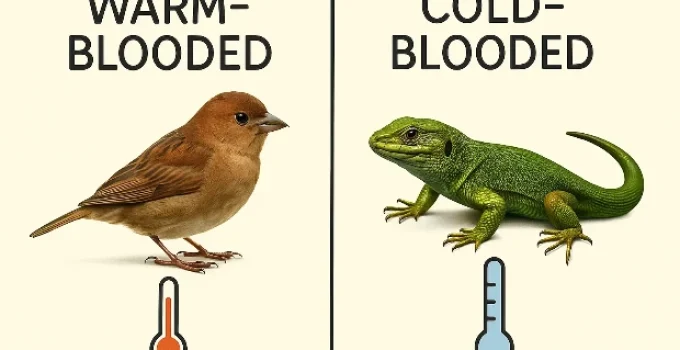⛏️Break It Down
- What Does Warm-Blooded Mean?
- How Do Warm-Blooded Animals Stay Warm?
- Are Humans Warm-Blooded?
- How Are Cold-Blooded Animals Different?
- Why Is Being Warm-Blooded Useful?
- Warm vs. Cold-Blooded Comparison Table
- 🎯 Final Thoughts
- 📚 References
What Does Warm-Blooded Mean?
Warm-blooded animals can keep their body temperature the same no matter how hot or cold it is outside. This is also called being endothermic, and it means the animal’s body makes its own heat using energy from food.
Warm-blooded creatures include mammals and birds. These animals don’t rely on the sun or warm air to stay active—they use their own energy to stay warm, even in the snow or deep ocean!
🌎 According to the National Park Service, warm-blooded animals can live in nearly every environment on Earth because of this ability.
Source
How Do Warm-Blooded Animals Stay Warm?
Warm-blooded animals use internal body processes to keep warm. Their bodies act like furnaces, burning energy from food to create heat. They also have other ways to keep their temperature just right:
- Shivering: Makes muscles move to produce heat
- Sweating or panting: Releases heat to cool the body
- Insulation: Fur, feathers, or fat trap body heat
- Behavior: Animals may huddle, burrow, or migrate
🦉 According to Britannica, a bird’s body temperature is much higher than a human’s at 105 °F.
Are Humans Warm-Blooded?
Yes—humans are warm-blooded mammals. Our bodies work to keep our internal temperature around 98.6°F (37°C), even if it’s freezing outside or blazing hot.
Our bodies do this by:
- Sweating when we’re hot
- Shivering when we’re cold
- Sending blood to or away from the skin to change heat loss
Clothes, heaters, and air conditioning help too, but your body does a lot on its own!
👶 According to the CDC, young children and older adults may have a harder time staying warm or cool because their bodies work less efficiently.
How Are Cold-Blooded Animals Different?
Cold-blooded animals, also called ectothermic animals, don’t control their body temperature from the inside. Instead, their body temperature changes with the environment.
Examples of cold-blooded animals:
- Reptiles (snakes, lizards)
- Amphibians (frogs, salamanders)
- Fish
- Insects
They warm up by basking in the sun or cool off by hiding in the shade.
🐍 According to the Journal of Thermal Biology, the average body temperature of an active cold-blooded is 95°F. Small reptiles can heat up and cool down more rapidly than large reptiles.
Why Is Being Warm-Blooded Useful?
Being warm-blooded helps animals:
- Stay active in cold climates
- Move quickly when needed
- Live in a variety of environments
- Keep a constant internal temperature for organs to work properly
But it also means warm-blooded animals need to eat more food to keep their energy and heat levels up.
🔥 According to the San Diego Zoo, if humans had a hummingbird’s metabolism, they would have to consume ~ 155,000 calories per day!
Warm vs. Cold-Blooded Comparison Table
| Feature | Warm-Blooded (Endothermic) | Cold-Blooded (Ectothermic) |
|---|---|---|
| Controls body temperature? | ✅ Yes | ❌ No |
| Energy source | Food (internal) | Environment (external) |
| Body temp in cold weather | Stays stable | Drops with outside temp |
| Activity in winter | Active or adapted | Often sluggish or inactive |
| Examples | Humans, birds, whales | Snakes, frogs, insects |
🎯 Final Thoughts
What does warm-blooded mean? It means an animal can create and control its own body heat using energy from food. Warm-blooded animals like mammals and birds can survive in all kinds of weather because their body temperatures stay the same. That’s a huge advantage—but it comes with a big appetite!
📚 References
💻National Park Service. “Mammals.” https://www.nps.gov/grte/learn/nature/mammals.htm
💻Britannica Kids. “Bird.” https://kids.britannica.com/students/article/bird/273225
💻Centers for Disease Control (CDC). “Heat and Older Adults.” https://www.cdc.gov/heat-health/risk-factors/heat-and-older-adults-aged-65.html
📝Florides, G. A., et al. “A Thermal Model for Reptiles and Pelycosaurs.” Journal of Thermal Biology, vol. 24, no. 1, Feb. 1999, pp. 1–13. https://doi.org/10.1016/s0306-4565(98)00032-1
💻San Diego Zoo. “Hummingbird.” https://animals.sandiegozoo.org/animals/hummingbird
📌Learn More About Mammals
- When Do Squirrels Hibernate? 🐿️How These Smart Survivors Outsmart Winter
- What Makes an Animal a Mammal? 🐾 The Traits That Set Mammals Apart
- Do All Mammals Have Fur? 🦭 The Fuzzy Facts Behind Mammal Life
- Which Mammals Lay Eggs? 🥚 The Eggstraordinary Rule-Breakers of the Mammal World
- Do Marine Mammals Breathe Underwater? 🐬 Explore How They Survive in the Sea
